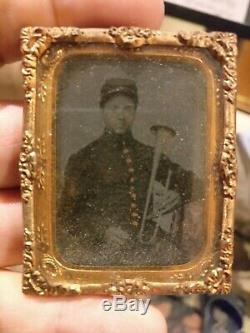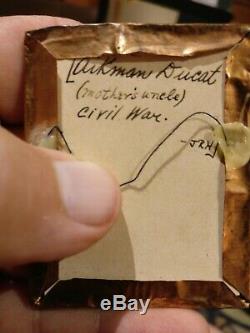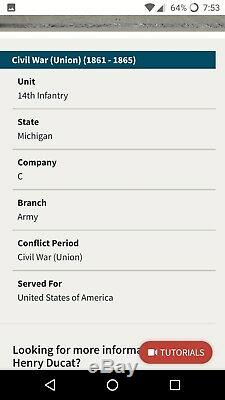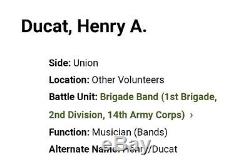
- Homepage
- Conflict
- Format
- Albumen (3)
- Ambrotype (28)
- Cabinet Card (56)
- Cdv (5)
- Crayon Portrait (2)
- Daguerreotype (24)
- Hardcover (11)
- Multi-formats (6)
- Negative Photo Image (4)
- Photograph (6)
- Ruby Ambrotype (3)
- Sixth Plate (2)
- Small (2)
- Stereoview (2)
- Tin Type (8)
- Tin Type Photo (2)
- Tintype (133)
- Tintype Photograph (6)
- Unknown (8)
- ... (6323)
- Photo Type
- Album (7)
- Albumen (14)
- Ambrotype (195)
- Cabinet Photo (63)
- Cdv (444)
- Cdv & Tintype (6)
- Cdvs (3)
- Cdvs & Tintypes (7)
- Daguerreotype (78)
- Gelatin Silver (13)
- Mixed (3)
- Negative (10)
- Negative Photo (4)
- Opalotype (4)
- Other (4)
- Photograph (4)
- Stereoview (23)
- Tintype (497)
- Tintypes (3)
- Unknown (11)
- ... (5241)
- Subject
- Children & Infants (21)
- Civil War (30)
- Civil War Soldier (12)
- Ethnic (17)
- Family (16)
- Fashion & Costumes (10)
- Figures & Portraits (145)
- Genealogy (10)
- Historic & Vintage (87)
- History (17)
- Men (53)
- Men, Civil War (47)
- Men, Military (34)
- Military (80)
- Military & Political (552)
- Military & War (14)
- Portrait (15)
- Portraits (14)
- Soldier (11)
- Women (16)
- ... (5433)
- Theme
- Americana (36)
- Americana, Fashion (15)
- Americana, Militaria (16)
- Antique (7)
- Art (5)
- Civil War (14)
- Conflicts & Wars (4)
- Fashion (17)
- History (39)
- History, Militaria (8)
- Love (6)
- Militaria (897)
- Patriotic (6)
- People (19)
- Politics (11)
- Portrait (57)
- Portrait, Man (22)
- Stamps (17)
- Stereoview (5)
- Victorian (7)
- ... (5426)
- Type
- Belt Buckle (3)
- Carte De Visite (2)
- Cdv (3)
- Cdv Photograph (14)
- Daguerreotype (3)
- Full Cdv Photo Album (2)
- Negative Film Photo (4)
- Pendant (3)
- Photo Album (3)
- Photo Frame (2)
- Photograph (1191)
- Photograph Album (39)
- Picture Book (7)
- Picture Frames (8)
- Print (3)
- Real Photo (rppc) (8)
- Tintype (9)
- Tintype Photo (4)
- ... (5326)
Known Michigan 14th Civil War Soldier tintype OTS Eb Cornet (Bugle Saxhorn) 9th






Known Michigan 14th Civil War Soldier tintype OTS Eb Cornet (Bugle Saxhorn) 9th plate image. Writing on back: Aikman Ducat (mothers uncle) Civil War. Aikman Henry Ducat was enlisted in the 14th Michigan Infantry, Company C Brigade Band. The Fourteenth was organized at Ypsilanti under the supervision of Colonel Robert P. Sinclair, mustering into the service of the United States on the 13th of February, 1862 with an enrollment of 925 officers and men. The Fourteenth left the state on the 17th of April for St. Joining General Grant's army at Pittsburgh Landing, Tenn. It participated in the Seige of Corinth, Miss.
And when the Confederates evacuated that city, the Fourteenth formed a part of General Buell's army, in the famous race with the Confederate army, under General Bragg, to Louisville, Ky. It went no farther than Nashville where it was assigned to the First Brigade, Second Division of the Fourteenth Corp, serving in that Corp throughout the remainder of the war. In November the Regiment had a sharp encounter with Alabama troops at Lavergne, Tenn.
Where it captured a fort and took a large number of prisoners. After a series of marches and victories the Regiment was at Stone River, Tenn. Where in January 1863, it took part in that famous engagement. The following March, Henry R.Mizner, a captain in the regular army was commissioned Colonel of the Regiment, Colonel Sinclair having resigned. The Fourteenth was on active duty during the summer at Franklin, Brentwood and Nashville, TN. Where Colonel Mizner mounted his Regiment by securing horses from the local farms, along with sufficient mules to move his transports and ambulances without calling on the government for an animal. His entire district was infested with guerilla bands and he pursued them so relentlessly that he killed or captured most of them, driving the remaining balance out of the state.
After the area was cleared of the lawless bands of guerrillas, peace reined as far as his troops could extend, causing many of the inhabitants to take the oath of allegiance to the United States. In January, 1864, the Regiment veteranized, with 414 men re-enlisting with the understanding and promise that they would continue their service as cavalry or mounted infantry. The companies came home by detachments on veteran furlough as the entire Regiment could not be spared as a whole. A bitter disappointment greeted them on their return as a sweeping general order had been issued to dismount the Regiment, causing the organization to serve once again as infantry. Much dissatisfaction followed and Colonel Mizner made a vigorous protest against the order; but, while the efficiency of his command was recognized, he failed to get the order revoked, submitting as gracefully as possible to the inevitable.
The Fourteenth joined General Sherman's army at Dallas, Ga. The 4th of June, where it took an active part in the Atlanta Campaign, being engaged with the Southern forces at Kenesaw Mountain, the Chattahoochie River, then the Seige of Atlanta. When General Sherman made his flanking movement around Atlanta, the Fourteenth distinguished itself by a brilliant charge at Jonesboro, breaking the Confederate line, being the first Union troops to take possession of the Confederate works. In this charge the Fourteenth captured General Govan, of Cleburn's division, along with his entire staff, four pieces of artillery, also the colors of the First Arkansas including 300 of its men. After the fall of Atlanta the Fourteenth was with Sherman's March to the Sea, reaching Savannah, Ga.
On the 16th of November. Upon the surrender of Savannah, the Regiment marched through South Carolina, crossing the Savannah River at Sister's Ferry, then through North Carolina, crossing around the Confederate lines while skirmishing at several points; then meeting strong resistance at Averysboro. The Brigade to which the Fourteenth belonged was ordered to charge the Confederate works, carrying the first line; but, were unable to take the main line. The Brigade held its position, expecting to resume the engagement the next morning, when it was found the Southern forces had retreated. The Regiment suffered severely in this engagement.
The following day the Fourteenth followed the Confederates closely until Bentonville was reached, where they made a determined effort to shake off their foes. General Johnston and Hardee massed their forces, then made a series of desperate charges upon the Union lines. The Confederates were received with a destructive fire and were repeatedly driven back, only to return, until the union forces jumped over their works, charging the Confederates, causing a total rout, capturing a large number of officers and men with a large quantity of small arms. In the meantime the southern forces appeared in the rear of the Union lines; whereupon the Fourteenth faced about, then charged the Confederates, when after a hand to hand struggle, drove them from the field with great loss in killed and wounded with a large number captured. This was the last severe battle of the Fourteenth and of General Sherman's army. The Fourteenth marched to Goldsboro, where it remained until April 10th, then started for Raleigh, N. It marched to Richmond from there and thence to Washington, D. Where on the 18th of May it took part along with the rest of General Sherman's army in the Grand Review held on the 24th. The Regiment was then sent to Louisville, Ky. Where it was mustered out of service on July 18th, then sent to Detroit where it arrived on the 21st.It was paid off and disbanded on July 29, 1865. Henry Ducat survived the war, settled in Portage Wisconsin, married in 1867 and had four children. He passed away about 1913. Image is pretty dark and dusty under the glass i have not opened it to clean to avoid damage.
The item "Known Michigan 14th Civil War Soldier tintype OTS Eb Cornet (Bugle Saxhorn) 9th" is in sale since Tuesday, May 28, 2019. This item is in the category "Collectibles\Militaria\Civil War (1861-65)\Original Period Items\Photographs". The seller is "jiarby" and is located in Mesa, Arizona. This item can be shipped to United States.
- Photo Type: Tintype

